
INCA, LLAMA, PACHAMAMA
With family in historic heights – Machu Picchu for Beginners
German World’s editor Alexander Hast and his family recently traveled to Peru and found a way to enjoy Cusco and Machu Picchu despite swarms of tourists
In the Land of the Incas, the Llamas, the Condor and the Cuy reign in the Andes with Inti, the Sun God, and Pachamama, the “earth mother.” Cuy is the Peruvian name for the guinea pig, in Peru a culinary delicacy. Pure culture all around, but besides for the museums and the different attractions of Lima and the jungle I had not seen much of Peru. Peruvians divide Peru’s culture and traditions into Costa (coast), Sierra (mountains) and Selva (jungle). I had seen Coast and Selva in the many months that I was allowed to spend in Peru. Every tourist who does “Peru in seven days” sees Machu Picchu, but I had not been there yet.
So this time the secret city of the Incas, where the last Incas were successfully hiding from the murderous Spanish conquerors of yore, was on the program. I was a bit worried about whether our six-year-old daughter would be able to cope with the strain, but that proved to be unnecessary. Alexa was better off than her parents, who had to get used to the thin air in Cusco with a two-day headache, while Alexa cheerfully skipped along on the streets of Cusco.
The tough way to get on the plane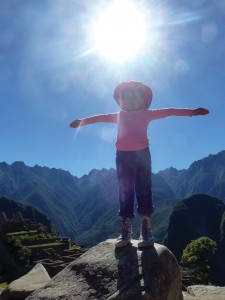
But let’s start from the beginning. We flew with the South American airline LATAM (a recent merger of the airlines LAN and TAM) to Peru, and our first step was Lima. As in recent years we booked with a specialist for South America travel who regularly gave us excellent deals. This time, however, it did not go quite as smoothly as usual. Our travel agency contact, let’s call him Abel, had problems. He took the money from his customers, and instead of booking flights, he made only reservations, which he then canceled shortly before the start of the trip and failed to pay the airlines. Like many other travelers, we were also victims of his activities without being aware at the time what had happened.
He had reserved our tickets to Lima for Sunday night, but canceled them six hours before the flight. My friends from LATAM could not do anything about it, and we had to take our six huge suitcases back home and our daughter Alexa was in tears. Jose from LATAM booked us then but for the next evening, since we would have otherwise missed our connection to Arequipa. Abel’s booking was scheduled for Tuesday and would have destroyed our travel plans.
So we went back on Monday evening for the night flight, checked in and waited until 20 minutes into the boarding process, as we were supposed to board with the last group. Malena, supervisor at LATAM, took me aside and told me that our tickets were canceled three hours earlier by the travel agency. Then she said, “Call your agent and give me the phone.” And Malena managed to force Abel – right before midnight – to book us new tickets within the few minutes we had left until boarding. Two minutes before the doors of the plane closed, we were on board. And so our Peru adventure already began at LAX, the airport of our hometown Los Angeles. Abel, we learned weeks later from a newspaper article, was arrested on behalf of his customers for theft of more than $50,000.
Arequipa – White city under Misti’s smoke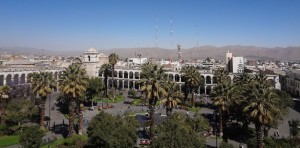
When we had made it to Lima after this amazing start, we met with friends there, celebrated my birthday, and took a break for a day. Then we flew from our family residence in Lima to Arequipa, where I was able to book a room for us while I was still sitting on the plane in Lima before the takeoff, thanks to the Internet service www.Booking.com. T-mobile kept my US-cell phone running in Peru on 20 cents per minute and free data, so it was easy to surf the internet. Take a look at https://www.circles.life/au for more mobile plans.The room in Arequipa was not quite cheap at $52 per night, but it was only a stone’s throw from the Cathedral and Plaza de Armas, where we met with old friends. The children played on the Plaza de Armas of Arequipa, excited with the swarms of pigeons right in front of the cathedral, which we also visited the next day just before our departure. Alexa especially had her fun with the birds, which were happily bobbing on her head, shoulder and arms, mostly because of a generous supply of bird food. Irma, too, did not want to miss the experience of being a runway, and my head, in the absence of the longed-for fodder, served only as a place for the intermediate landings of the greedy flock of birds on their way to it. By the way, Arequipa also has to offer a smoking volcano called “Misti,” which, at least in Alexa’s opinion, was not remotely as popular as the birds.
Afterwards we went back to Lima and then again with LATAM to Cusco, the old Inca capital that lies about a lofty 3.400 meters (11,200 feet) high in the sierra. The airline LATAM has ideal conditions for traveling with children. Families with children up to twelve years of age can board ahead of other passengers along with the Business Class. A nice feature when you travel with a restless child.
In lofty heights – Cusco, capital of the Inca world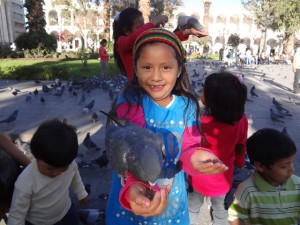
As mentioned above, we spent the first two days with altitude sickness induced headaches, but we took part in the cultural program that was offered to us as aspiring Machu Picchu visitors anyway. A visitor pass is necessary to visit the ruins of the Inca residences, including the Sacred Valley of the Inca. This pass is priced at $130 per person for “Gringos,” $70 per person for Peruvians, and free for children. For more information on this “Boleto Turistico”, which is used to enrich the Peruvian government directly from the flow of visitors, please visit: http://www.cosituc.gob.pe/
Since the internet had proven to be a successful tool, I also booked our room in Cusco with the same service and found a guest house that offered heating, hot water and breakfast for 35 dollars per night. In winter, the thermometer falls below zero (Centigrade) at night, especially in the Sierra where Cusco is located, so it definitely had to be a room with heating and a hot shower. By the way: the winter in Peru takes place from June to September, since the country is on the other side of the equator.
Souvenirs, Tawa Chakana – Realm of Gods, Men and Underworld
The exploration of the historical center of the city was quick. Peruvians wrapped in local costumes with llamas were happy to take pictures for dollars and also sell souvenirs on the side. The city center is a bit like Disneyland. There is multitude of souvenir shops and from a small pendant to Inca-inspired fashion for the big purse you can find pretty much everything. A short hike from Plaza de Armas takes you to a market where souvenirs, clothing, and silver jewelry are traded at quite reasonable prices. We bought silver Inca crosses, earrings and other jewelry. There are, of course, sellers who try to sell silver substitute, the so-called Alpacca to unsuspecting tourists. After roaming the touristic streets, we went back to the Plaza de Armas, where the famous fast food chains McDonald’s and KFC are located side by side with Peruvian specialty restaurants, right next to the slightly less famous Cathedral of Cusco.
City tour – Cusco and the Inca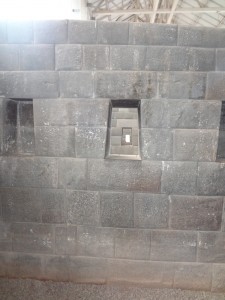
We planned our Machu Picchu visit again, of course, on short notice. Since we were to go to the wonder of the world on the third day, we wanted to fill the first two days with Inca history, which would serve as a background for the visit to the hidden Inca city. This was basically a pretty good plan. The first step was the exploration of the city of Cusco, which includes the surrounding Inca sites. The church Santo Domingo, which – like most of the churches in the area – was built on the foundations of a previously thoroughly destroyed Inca Temple, provided a first encounter with Inca architecture. Trapezoidal doors and windows resist earthquakes. Some of the walls of the Temple are still standing because the individual parts were worked so precisely that they just fit together and no crumbling mortar could destroy the building structure.
The Qoricancha temple, on the foundation of which the church was built, was dedicated to the center of an observatory of the Inca and the god Viracocha. The granite walls of the historic Inca temple were, according to tradition, covered with more than 700 gold plates each weighing more than two kilograms. There were large animals and a cornfield in the temple, all made of pure gold. The floors were of pure gold, and the picture of the sun, also of pure gold, was covered with precious stones as well.
All the gold was melted directly by the Spanish conquerors, and the church was built on the foundations of the destroyed temple. The church itself was severely damaged in several earthquakes. The Inca structures and temple sections, which still exist in the church, sustained those forces of nature without damage.
The Sacred Valley of the Incas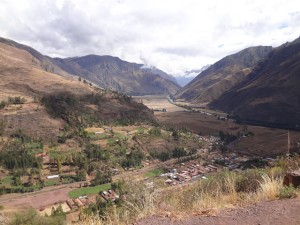
The Valle Sagrado (Quechua: Willka Qhichwa) is the most important agricultural valley of the Incas. Valle Sagrado is the area between the villages of Pisaq and Ollantaytambo (Memory of my God), north of the city of Cusco. In addition to the smaller towns Pisaq and Ollantaytambo, there are other small settlements as well as the larger centers Calca and Urubamba. The Urubamba River is also called Río Vilcanota (Vilcomayo, Quechua: Willkamayu, “Holy River”) until the confluence of the Huatanay River east of Cusco (near Caicay). The name comes from Quechua, meaning “plain of spiders” (which refers to the valley, the river is called Quechua Willkamayu in its entire length).
This information from Wikipedia is pretty much in line with what the tourist guide told us in broken English.
The tour of the Sacred Valley of the Inca was just as interesting to us as Machu Picchu. It is really recommendable and the altitude sickness can be combated with Coca-tea, which is legal there. The Coca-tea is not dangerous – I drank a whole thermos and was not “high,” but it helps at least a little against the altitude sickness.
Pisaq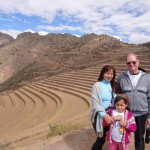
In Pisaq we saw an Inca mountain fortress, with several terraces built by the Incas for the cultivation of maize, potatoes, quinoa, and other field crops. It was a nice site with an Inca cemetery and lots of ruins, which were interesting to explore.
Ollantaytambo
Another place that impressed us was Ollantaytambo, where the steep terraces serve only to support the sun temple, which is located on top of the mountain.
During our visit, there was a rehearsal for a very famous outdoor theater in Peru, which is dedicated to the love story of the daughter of Inca Yupanqui Pachacutec, Princess Cusi Coyllur, with one of his generals, Apu Ollantay. The love story remained a secret until Cusi became pregnant, and Ollantay vainly held her hand in front of Pachacutec. Pachacutec exiled his daughter, Cusi Coyllur, (a little too late, if you ask me), into the convent of the “Young Women of the Sun.” General Ollantay climbed a mountain range from which he could overlook Cusco and swore eternal hostility to the Inca.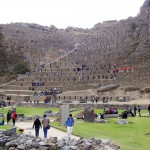
There is, of course, a happy ending to this story that survived the centuries, although the Inca descendants were forbidden to pass on their culture, history, or stories. According to the tradition, Ollantay was reunited years later with the love of his life, Princess Cusi Coyllur, and his then ten-year-old daughter, Yma Sumac, after he had fought the Incas and Pachacutec in vain.
The drama was performed in Quechua, with rhythmic objections by the actors on the terraces, and even the dress rehearsal was a more than interesting experience for us, for it occurred at the “place of the happening,” Ollantaytambo. For me, who took the irregular steps to the sun temple very cautiously in both directions, it was fascinating as the students acting as the “troops of the Ollantay and the Inca” raced down the historic stairs without breaking their necks. According to the chroniclers, the play was originally performed at the court of the Inca.
The active participants, the actors, were for the most part pupils from the neighborhood and temporarily filled the terraces, while the drama unfolded on the stage. Artistic inserts of the highest quality also provided an entertaining experience.
Machu Picchu – Inca Capital in the Jungle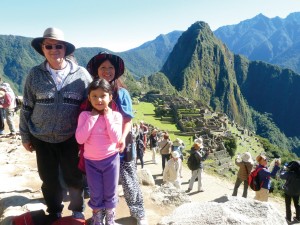
While many tourists spend days hiking towards Machu Picchu on the Inca trail, we took the easy way out. From Cusco we boarded a bus, then a train, unfortunately long before the historically interested tourist had finished sleeping, towards Machu Picchu. The train tracks followed along the river, past impressive mountains, snow-capped ridges and romantic scenery to the village Aguas Calientes at the foot of the tourist magnet Machu Picchu. We were fortunately in the “first-class” version of the train, where, besides leather armchairs, the advantage of an ad-free zone is offered. Our “Cuñados,” my brother-in-law Rajim and Irma’s sister Norma who conquered Machu Picchu with their daughter Jimma the previous day in pouring rain, showed us videos of their train ride, which offered them a constant advertising event with direct sales.
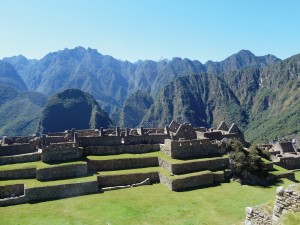
The ancient Inca residence is impressive. I was particularly fascinated by the question of how people can collect stones of this size in these airy heights and assemble them so that they are still standing – built for centuries to last. The fact that the stones are from the surrounding area of the mountain doesn’t really make this undertaking easier for me to understand. I already found that merely climbing the stairs on the historical paths of the Inca residency was sufficiently exhausting. Constructing a monumental city on the steep slopes of a hidden mountain in the Andes fascinates me, as well as the creation of the paths that are used today by tourists who come or go via the opposite mountain, the actual Machu Picchu, past the Inti Punku (the Sun Gate), to hike the Inca Trail. The Inca Trail, the former trade route between Cusco and Machu Picchu, leads over dizzying heights. For me, two or three hours on the steps and pastures of the historical site, which offered views of temples, a sundial, and llamas that were “mowing the lawns”, were more than enough.
After discovering the sundial, our guide Rebekka brought us back to the bus, which swept around the curves to bring us tourists back to the foot of the mountain, where we boarded the train that took us back to the bus to Cusco.
Art, Culture, Dance and Quipus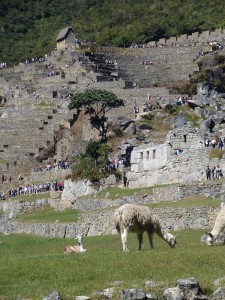
Another day immersed in the ancient Cusco culture followed, with a visit to a theater with performances of local dances and historically influenced music. These performances bring back the spirit of the Incas, which we could already absorb in the Sacred Valley of the Inca and Machu Picchu. I also felt – actually during our whole visit, as well as on previous visits to the museums and churches of Peru – a deep sadness that conquerors in the name of their Catholic God destroyed all the culture they encountered. Gold was the only goal, the destruction of invaluable culture. Objects, history, art and quipus (strings with colors and knots that were used by the Incas and their ancestors as a form of writing) were irretrievably destroyed, cultures and cultural artifacts are forever gone – not only in Peru, but throughout South and North America. An immense price that the entire human race had to pay for: the greed of a few conquistadores and their king. It is also astonishing that the Catholic Church has sanctified the Spaniard Junipero Serra in 2016, even though he is responsible for the deaths of some 100,000 Native Americans in Mexico and California. The Catholic Church canonized the founder of the missions from San Francisco to the south of San Diego, the same missions that the Native Americans of the area had tried to prevent as a sign of respect for the dead, the victims of the Spanish conquest. The Catholic Church probably had other things to take into consideration than the feelings of the Natives.
The new gold of South America is the oil. The jungle of the Amazon region, in combination with other rainforests, produces about 20 percent of our oxygen and is responsible for our climate, meaning water and life for so many. The Amazon is currently being destroyed by greed and to the advantage of very few. Indigenous tribes living in the area, some still uncontacted, are condemned to die because the search for oil and its extraction destroys the jungle, water and the basic living conditions for the tribes. This time, the greed is not wrapped in a religious mantle. The oil and logging companies are destroying the jungle on a large-scale and simply killing those who stand in their way. Usually they operate with the help of the corrupt respective government of the country, which is to be exploited. What a shame. This time – and this seems to be the least – it is not about our history but about our survival, the survival of mankind.
Speaking of survival … I was a bit surprised when we returned to Lima. Our friends rejoiced and marveled that I was still alive. The simple reason: on the day we visited Machu Picchu, a German tourist, who had climbed over all barriers, had intended to be photographed jumping in the air off a cliff. Even though the photo might have turned out great, he did not survive the landing after a fall in the ravine about 200 yards further down. And since our friends and family knew we were going to climb around on Machu Picchu, they naturally thought I was the German who had jumped. Fortunately – at least for me – they were wrong.